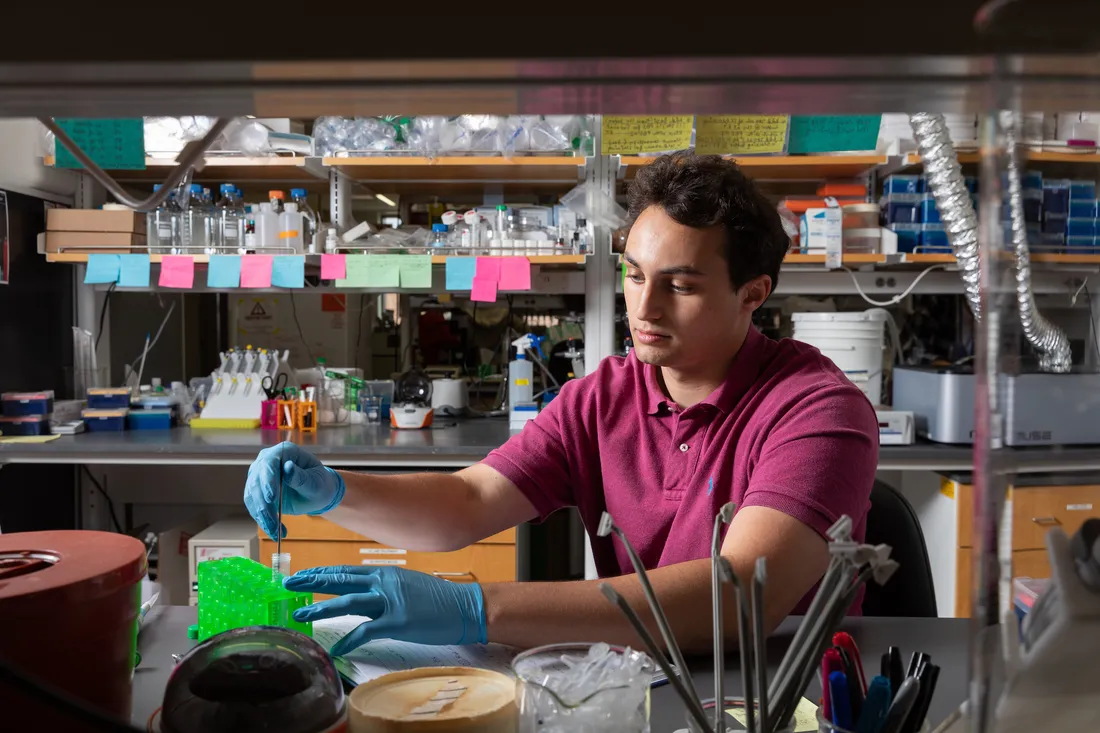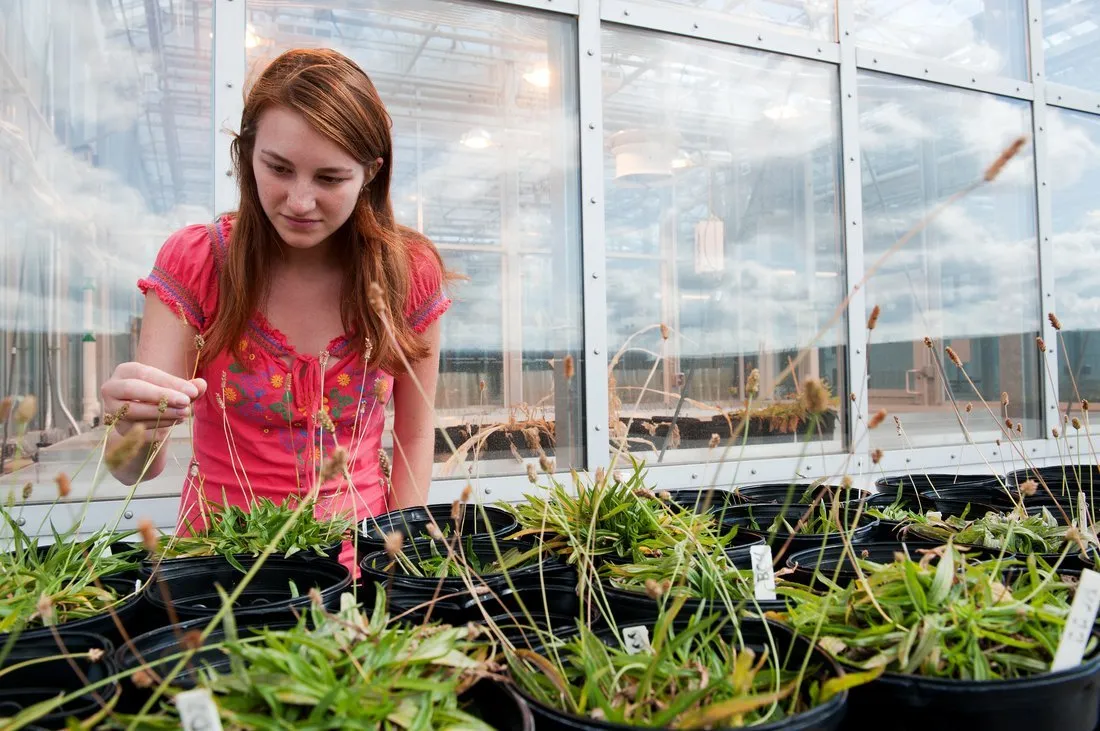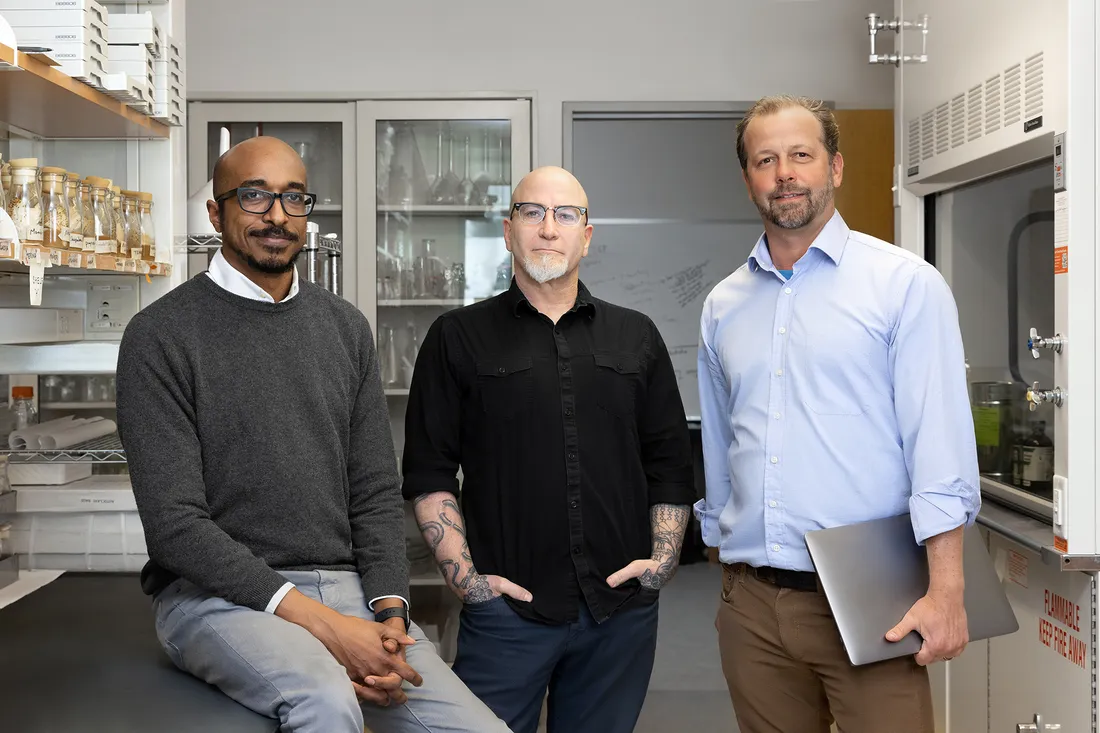
Biology professors (from left) Yasir Ahmed-Braimah, Scott Pitnick and Steve Dorus in the Center for Reproductive Evolution, located in the Life Sciences Complex.
Scientists generally agree that evolutionary biology was born in 1859 with the publication of Charles Darwin’s On the Origin of Species. The idea that species can mutate (i.e., change over time) was not new. Decades earlier, Darwin’s grandfather, Erasmus, had proposed something similar, designing a ladder-like diagram to show how humans evolved from single-celled organisms. Darwin went a step further, suggesting that natural selection was the mechanism by which species adapted to their environments.
But there’s more to the story, admits Steve Dorus, associate professor of biology at Syracuse University. “Darwin surmised that natural selection wasn’t just about survival. He argued that some of the most dramatic differences between species were reproductive traits like ornaments and armaments,” says Dorus, referring to peacock tails and beetle horns, respectively. “These traits came about because they were subjected to a type of selection associated with reproductive competition.”
Darwin called his new theory “sexual selection,” which he outlined in his 1871 tour-de-force, The Descent of Man, and Selection in Relation to Sex. Whereas Origin sidestepped human evolution, Descent tackled it head-on. The thought of males vying for access to females, who, in turn, desired the biggest, most attractive mates, brought evolution into sharp focus. “Natural selection and sexual selection explain how species have evolved over time,” Dorus adds.
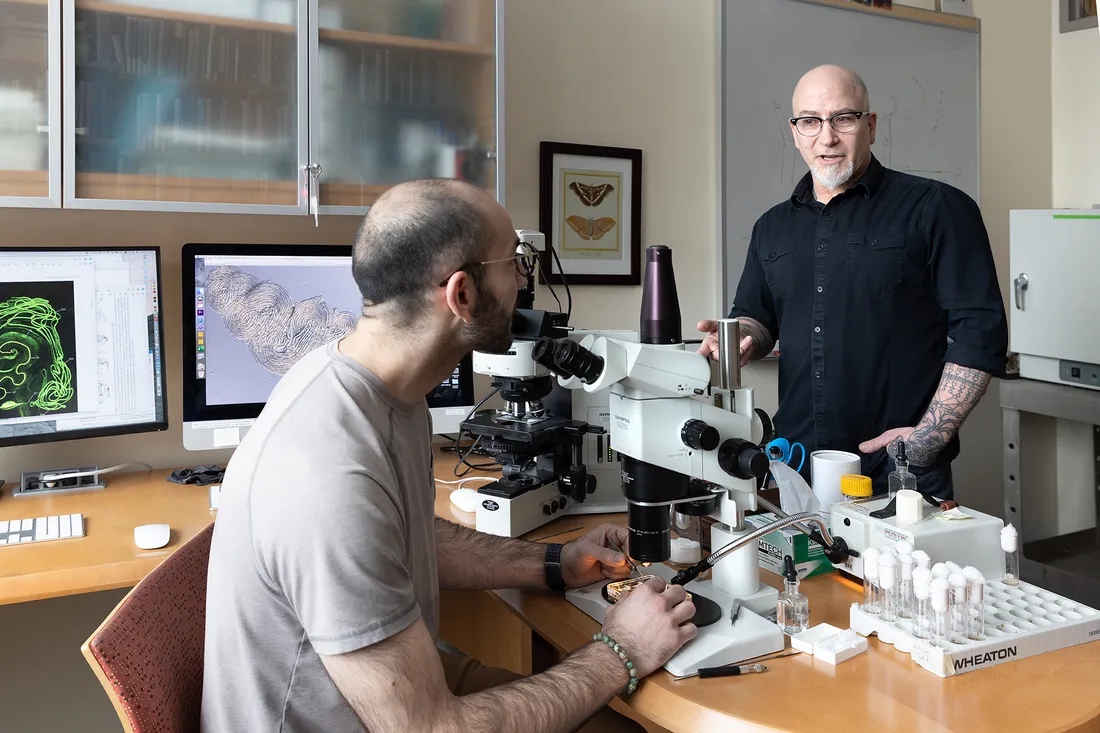
Pitnick (far right), a world-renowned evolutionary biologist, helped found the CRE in 2016.
Lord of the Flies
Analyzing the origins of biodiversity is at the heart of the Center for Reproductive Evolution (CRE) in the College of Arts and Sciences. Housed in the biology department, the CRE explores patterns and processes of sexual selection, including their underlying molecular mechanisms and genomic consequences.
The center was co-founded by Dorus, Weeden Professor Scott Pitnick and Professor Emeritus John Belote in 2016. A shared interest in the study of reproduction—along with a recognition of the “potential synergism of combining our research efforts,” Pitnick says—persuaded everyone to join forces. The 2019 appointment of Assistant Professor Yasir Ahmed-Braimah has brought additional expertise in genomics and bioinformatics.
“Our philosophy is grounded in interdisciplinary science,” says Dorus, who, like his colleagues, studies diverse biological systems, including flies, beetles, mammals, birds and fish. “The Center for Reproductive Evolution offers complementary approaches to fundamental questions about sexual and ecological selection, diversification and speciation, and evolutionary genetics and genomics.”
The team’s workhorse is the common fruit fly. Formally known as Drosophila, this small, ubiquitous creature is one of the oldest, most effective genetic model organisms. That they are easy and inexpensive to culture in a lab environment is a boon to the CRE.
And thanks to new and emerging technologies (along with funding from agencies like the National Institutes of Health and National Science Foundation), the CRE is helping rewrite the rules of biological research. The center is collecting, storing, analyzing and disseminating information like never before, Dorus says. “What was once impossible is now commonplace.”
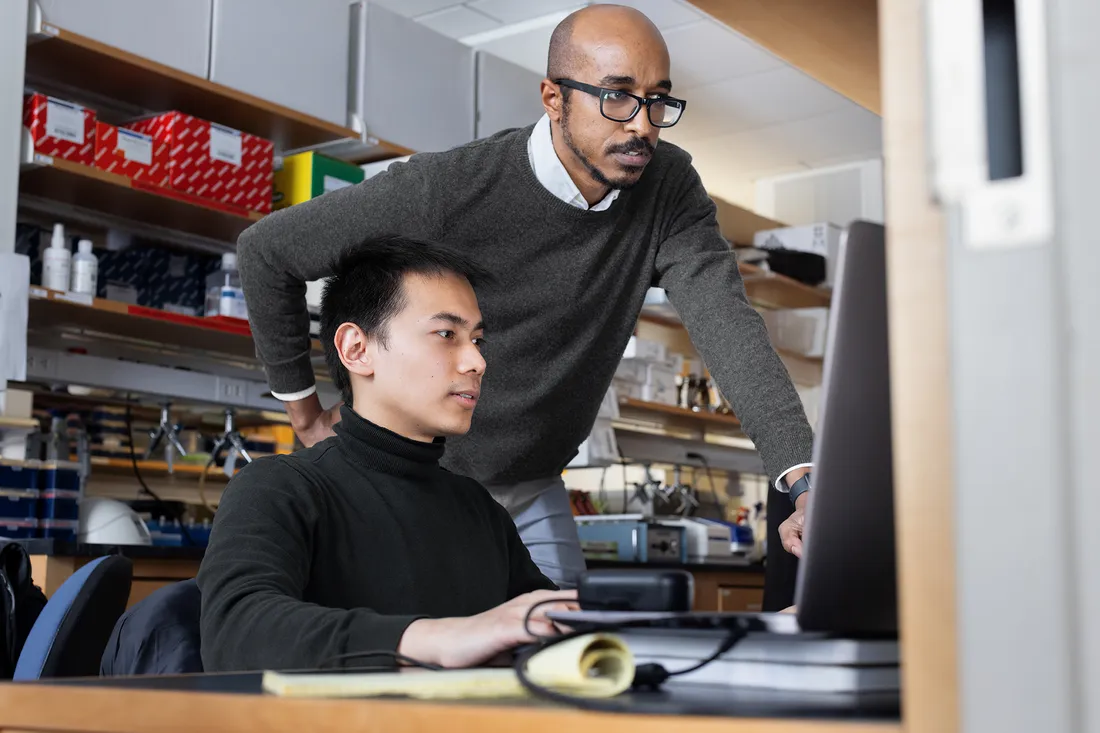
Ahmed-Braimah (standing) is part of a new wave of computer-savvy scientists, blending technology with biology to interpret genomic data properties.
An Explosion of Data
The CRE is part of the University’s Big Data and Data Analytics research group. Established in 2018, the group develops and applies data analysis methodologies to various fields, including genomics—the study of an organism’s genes. “Working at the nexus of evolutionary biology, genomics and computer science means dealing with copious amounts of data,” says Dorus, who helped found the group with Pitnick and several others, including Professor Chilukuri Mohan, an artificial intelligence expert in the College of Engineering and Computer Science.
In addition to resolving behavioral, morphological and physiological mechanisms of reproduction, the CRE excels at genetic mapping and characterization—determining the location and function of genes that confer specific phenotypes. Such research explains why individuals of a species often have similar, but rarely identical characteristics. (Think eye color, skin tone or face shape in humans.) Genetic mapping also provides insights into complex evolutionary processes stretching back millions of years.
Ahmed-Braimah is part of a new wave of Syracuse scientists fluent in ’omics-based technologies and advanced algorithms. (’Omics refers to subdisciplines like genomics, transcriptomics, proteomics and metabolomics.) “Technology is rewriting the rules of biological research,” says Ahmed-Braimah, the Big Data group's first biology hire. “Whereas we used to have lots of theory and little data, we’re now inundated by data.”
New Approaches to Old Problems
To appreciate the science of the CRE is to understand the complex relationship between sperm and the female reproductive tract (FRT). Only since the 1950s have scientists confirmed that the FRT plays a key role in sperm maturation, a process in which sperm cells become “competent” to fertilize eggs. Sometimes sperm are not compatible with the FRT where they reside, leading to what is known as idiopathic infertility. “It’s a major human health burden,” says Dorus, adding that the disease strikes about 30% of infertile couples worldwide.
Technology is rewriting the rules of biological research. Whereas we used to have lots of theory and little data, we’re now inundated by data.
Professor Yasir Ahmed-Braimah
Caitlin McDonough-Goldstein G’20, a postdoctoral researcher at the University of Vienna, became interested in idiopathic infertility while a student at Syracuse. Under Dorus’ and Pitnick’s supervision, she tested thousands of tissue samples from Drosophila FRTs. Analyzing the flies’ gene expression and protein production helped McDonough-Goldstein understand the FRT’s molecular nature. It also made her realize how changes after mating can regulate reproductive events and ensure fertility.
McDonough-Goldstein’s work serves as a blueprint for other studies of ejaculate-by-female interactions. For instance, it has informed those by former CRE postdoctoral researcher Erin McCullough, now an assistant professor of biology at Clark University in Massachusetts, and former Syracuse Ph.D. student Emma Whittington G’19, a postdoctoral research fellow at the University of Oslo’s Natural History Museum.
Whittington, in fact, discovered that female-derived proteins contribute to sperm composition in the FRT. Although the precise ramifications of her findings are still being evaluated, they suggest that males and females contribute to sperm production. “The development of sperm transcends the male and female reproductive tracts, requiring sophisticated molecular continuity and cooperation between the sexes,” says Dorus, adding that Whittington’s findings were the subject of a recent cover story in Proceedings of the National Academy of Sciences.
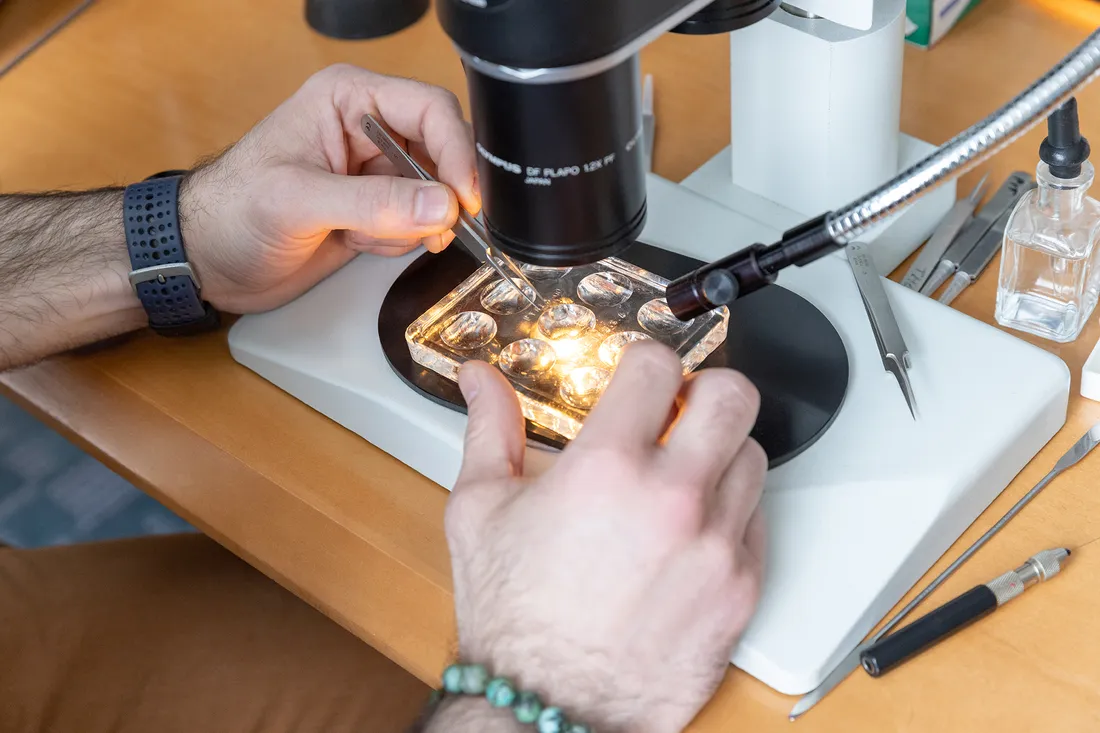
Members of the CRE study about 150 species of Drosophila, common fruit flies whose genetic makeup is similar to humans’.
Comparative Biology of Epic Proportions
Zeeshan Syed, a fourth year CRE postdoctoral researcher, revels in laboratory and computational biological research. Witness his involvement with the CRE’s Drosophila Evolutionary Phenomics (DEP) project, which considers the evolution of biodiversity on an unrivaled scale.
Syed is part of a team of researchers quantifying about 25 complex traits in 150 different species of fruit flies. The traits include body dimensions, sex-specific lifespan, patterns of reproductive aging, sperm and egg morphology, courtship and remating behavior, to name a few. “It’s work that’s 50 million years in the making,” he says.
Involving colleagues from Cornell and Stanford universities, the DEP project aims to sequence the full genomes of all 150 species. “It’s hard to imagine a bigger ‘Big Data’ project than this one,” says Ahmed-Braimah, adding that such initiatives are a “dream” for scientists of his ilk.
Still, the DEP project is an exercise in logistics, what with maintaining live cultures of many different species and running myriad experiments to measure their diverse traits. One of Syed’s jobs is to organize the activities of a small fleet of undergraduates. (Some 30 biology majors have logged more than a thousand hours on the project over the past four years.) He’s also responsible for providing individualized training in fluorescence microscopy and morphometric analysis, the latter of which is used to measure the length of fly sperm.
“If you want to conduct big data science, you need to be prepared to lead a diverse team of researchers,” Syed says. “Working with professors Pitnick, Ahmed-Braimah, Dorus and Belote on the DEP project has been a once-in-a-lifetime opportunity, turning me into a well-rounded, highly integrative biologist.”
Pitnick, for one, thrives on working with young researchers. “Our undergraduates are curious, insightful and creative,” he says. “Many of them improve our research in meaningful ways, and nearly all of them co-author multiple publications.”
Case in point: Pitnick protégé Amaar Asif ’22 was among a handful of undergraduates who co-authored a major paper for the peer-reviewed Cells. The lead author was Pitnick, who, while measuring fly sperm, uncovered a “novel developmental mechanism” enabling flies with small testes to produce unusually long sperm. For Asif, the chance to contribute to such a discovery was transformative.
Our undergraduates are curious, insightful and creative. Many of them improve our research in meaningful ways, and nearly all of them co-author multiple publications.
Scott Pitnick, Weeden Professor of Biology
“There’s so much we don’t know about this mechanism, and there are very few science papers to reference it,” says Asif, who earned bachelor’s degrees in biology and neuroscience. “It’s uncharted territory.”
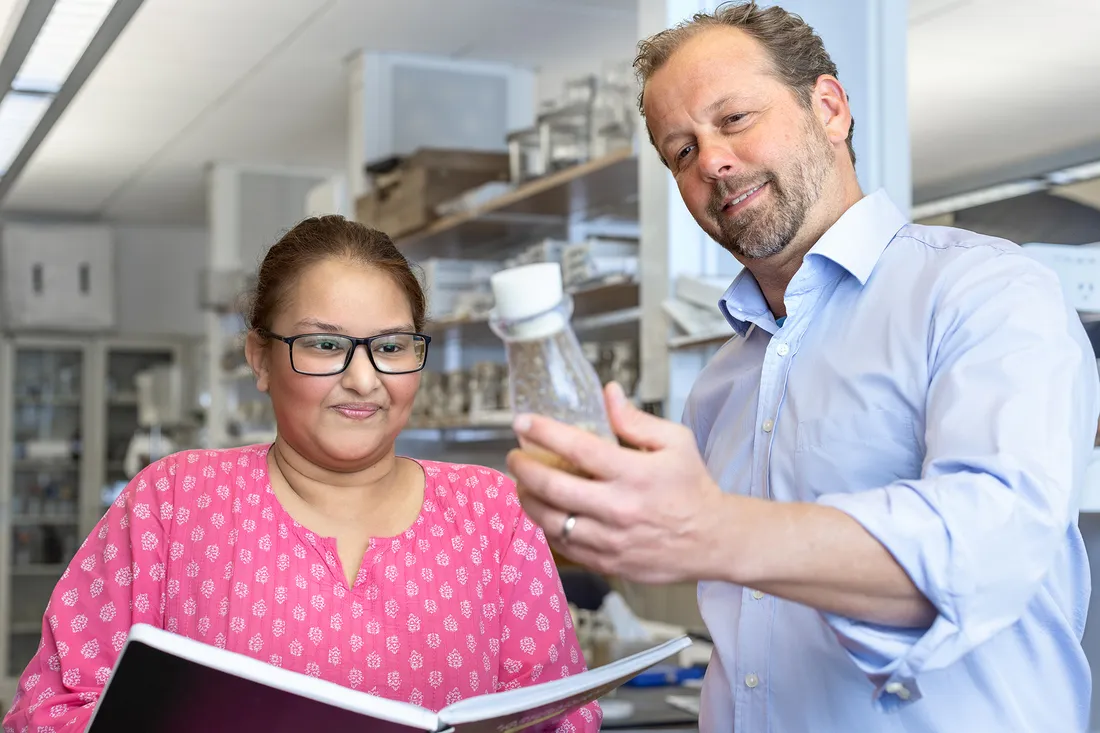
Ph.D. student Amisha Agarwala with Dorus, whose research into biodiversity may hold clues for disease and climate change.
Mapping the Future
An ongoing priority for the CRE is to understand the evolutionary link between sperm and FRT length. Pitnick laid the foundation in the 1990s, when he found that sperm in some species of Drosophila can grow up to two and half inches in length—20 times longer than the fly itself and a thousand times longer than average human sperm. Pitnick also realized that as sperm became larger and fewer in number, the females got less of them per copulation. “As few as a couple dozen sperm per mating, in some cases,” he points out. “This caused the flies to mate more often.”
The takeaway here is that big, high-investment sperm have a better chance of penetrating the limited storage space of the FRT. “Making giant sperm isn’t easy—it takes a lot of energy,” Pitnick continues. “Our research demonstrates that female choice and male competition require considerable investment on both sides.” Thus, CRE strives to figure out how genetic and molecular mechanisms work together in an evolutionary sense.
The CRE helps us make sense of biodiversity and our place in it, not to mention the problems facing humanity, like disease and climate change.
Scott Pitnick, Weeden Professor of Biology
Of course, tasks that used to take years to complete, like assembling an organism’s genome, can now be accomplished in days or weeks. And with breakthrough studies of cellular and molecular mechanisms, scientists like Ahmed-Braimah can interrogate trait evolution with unrivaled speed and clarity. His current research into the changes that female Drosophila undergo after mating—changes that influence feeding behavior, metabolism, immune function and egg production—is incumbent on a slew of materials and methods.
“Because functional genomics research provides a vast readout of cellular and molecular processes, we can access an immense amount of information. This helps us develop testable hypotheses more quickly,” says Ahmed-Braimah, a computational and evolutionary genomicist.
Pitnick agrees, lauding the “incredible variation” that stems from natural and sexual selection in terms of the traits themselves, their underlying genetics and their interactions. “This variation helps us make sense of biodiversity and our place in it, not to mention the problems facing humanity, like disease and climate change,” he concludes. Perhaps part of the solution is found in a fly buzzing around your overripened fruit.

